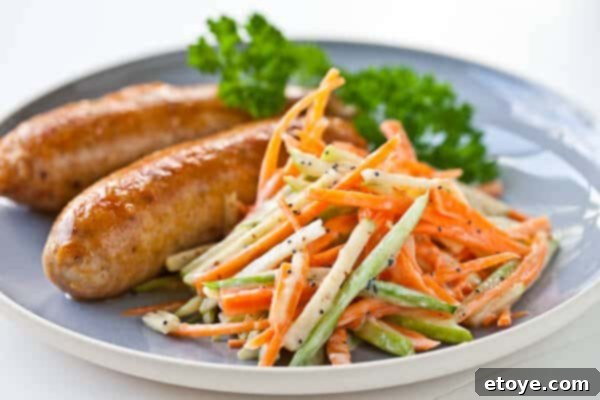
This past weekend delivered an unexpected and rather delightful heatwave, a meteorological anomaly that most of the population would undoubtedly welcome with open arms. For many, a sudden 85°F day, especially when the calendar suggests cooler temperatures, is a perfect excuse for outdoor adventures and a change of pace. However, for me, this pleasant weather presented a slight, albeit amusing, dilemma. I had recently invested a significant sum in a collection of winter essentials – think plush wool scarves, cozy earmuffs, and stylish gloves – all meticulously chosen for an upcoming trip to the bustling, often chilly, streets of New York City. My internal financial auditor was still working overtime, attempting to justify these purchases by projecting at least forty more uses for my cold-weather gear this season. Only then, I reasoned, could I truly feel satisfied and declare, “Wow, I’ve genuinely gotten my money’s worth!”
Unfortunately, the glorious 85°F weather was in direct opposition to my somewhat neurotic need to wring every last penny’s worth out of those earmuffs. My resolve quickly melted under the sun, and I found myself inevitably slipping into flip-flops and capris. This sartorial surrender quickly dictated a shift in my culinary endeavors too. Gone were the thoughts of hearty, warming stews or comfort foods typically associated with cooler weather. Instead, my kitchen naturally gravitated towards lighter, more refreshing fare, leading to the creation of this vibrant Chicken Sausage with Apple Slaw – a perfect, adaptable meal for those delightfully confusing days when the weather simply refuses to conform to expectations.
Embrace Fresh Flavors: Discover the Delight of Chicken Sausage with Apple Slaw
In a world of unpredictable weather and ever-evolving cravings, having a versatile and utterly delicious recipe like Chicken Sausage with Apple Slaw in your culinary arsenal is an absolute game-changer. This dish is far more than just a meal; it’s a celebration of simple, wholesome ingredients coming together to create an impressive symphony of tastes and textures. The foundation is laid by savory, perfectly cooked chicken sausage, offering a satisfying protein-rich component. This is beautifully complemented by a crisp, vibrant apple slaw, which introduces a refreshing counterpoint of sweet and tangy notes. Together, they create a balanced and deeply satisfying eating experience.
This recipe shines as an ideal choice for a quick and light lunch, a flavorful weeknight dinner that comes together with ease, or even as an exciting addition to your next outdoor gathering or picnic. It’s a meal that effortlessly bridges the gap between seasons, offering comforting flavors without feeling heavy, and a refreshing zest without overwhelming the palate. Whether you’re navigating an unexpected heatwave or simply seeking a fresh, healthy option, this Chicken Sausage with Apple Slaw promises a delightful culinary escape.
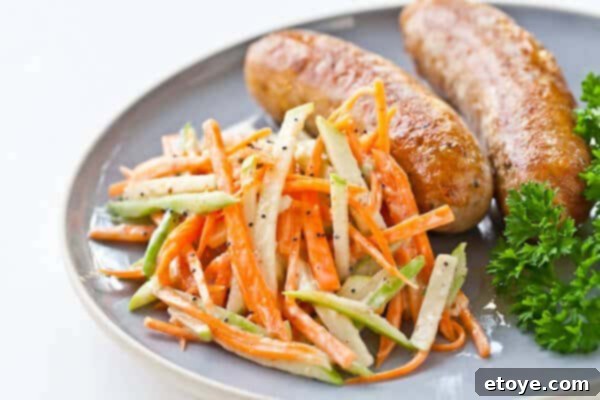
The Art of the Cut: Why Precision Matters for the Perfect Slaw
When you set out to create an truly exceptional slaw, the secret to its success often lies in a surprisingly simple yet crucial detail: the precision of your cuts. Achieving a uniform shape and size for all your vegetables is not merely an aesthetic choice; it’s a fundamental culinary technique that profoundly impacts the overall texture, flavor distribution, and enjoyment of the dish. Imagine a bite of slaw where you encounter an inconsistent mix of tough, stringy pieces alongside overly chunky and unwieldy ones. Such variability can significantly detract from the pleasure of eating, making each mouthful a disjointed and often less satisfying experience.
By committing to consistent knife work, you ensure that every single ingredient contributes harmoniously to the slaw’s texture and taste. This meticulous approach guarantees that each forkful delivers a perfectly balanced blend, allowing the distinct flavors and textures to meld seamlessly. It eliminates the frustration of dealing with “stringy this” or “knobby that,” instead presenting a beautifully integrated salad where every component plays its intended part. This attention to detail creates a delightful mouthfeel, ensures the dressing coats every piece evenly, and ultimately makes the slaw an absolute joy to eat, right down to the very last spoonful.
Mastering Celery: Techniques for Tender, Less Stringy Strips
Celery, with its inherently fibrous structure, can sometimes be a challenging ingredient to integrate seamlessly into a slaw. To overcome its potential stringiness and enhance its tenderness, I employ a simple yet remarkably effective two-step technique. Firstly, before slicing, I gently run a vegetable peeler along the outer stalks of the celery. This seemingly minor step is incredibly effective in removing those tough, stringy bits that often get caught in your teeth, resulting in a much smoother and more pleasant texture in the finished slaw.

The second crucial element is the angle of your cut. Instead of slicing the celery perpendicular to its length, which tends to highlight its fibrous nature, I make thin slices at a very extreme diagonal. This diagonal cutting method serves multiple purposes: it creates longer, more elegant pieces that add a refined visual appeal to your slaw. More importantly, by slicing across the natural “grain” of the celery, you effectively shorten its tough fibers, which makes the celery significantly more tender and reduces its stringiness. If you’ve ever prepared celery in traditional sticks, you’ll immediately notice the dramatic difference in texture and pliability achieved by this diagonal technique. This method elevates humble celery from a mere crunchy background element to a truly delightful and integrated component of your slaw.

After expertly creating these perfectly angled slices, the final step for preparing the celery is to transform them into elegant julienne strips. To do this, I simply line up the diagonally cut pieces lengthwise on my cutting board and make one more precise cut with my sharp knife. This process yields slender, uniform matchstick-like pieces that will integrate beautifully into the apple slaw. These fine strips ensure that every bite offers a harmonious combination of flavors and textures, entirely free from any unwelcome, tough stringiness. This attention to detail in celery preparation is key to achieving a truly refined and enjoyable slaw.
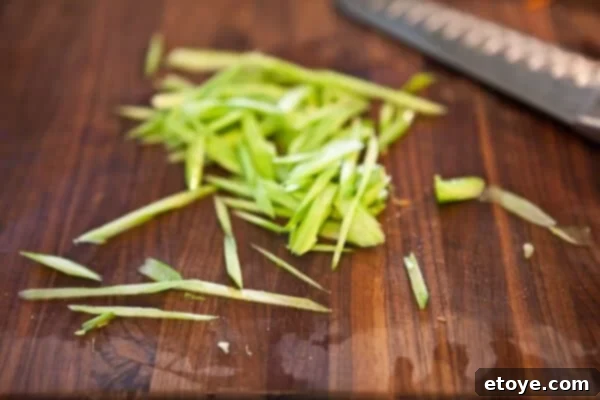
Perfecting the Apple Cut for Crisp Slaw
Apples are a star ingredient in this slaw, contributing a delightful tartness, a burst of juicy flavor, and an essential crisp texture that beautifully complements the other components. For optimal results and ease of eating, precise preparation is key. I begin by carefully cutting the fruit off of each side of the apple, working meticulously around the central core. This technique not only minimizes waste but also provides flat, stable surfaces, which makes the subsequent slicing steps much easier and significantly safer.

Once you have these core-free apple segments, the next step is to slice them thinly. The goal here is to achieve slices that are consistent in thickness, as this uniformity will directly contribute to the overall balanced texture of the finished slaw. Thin slices are absolutely crucial; they prevent the apple from being too overpowering in any single bite and ensure it blends seamlessly with the other delicate ingredients.
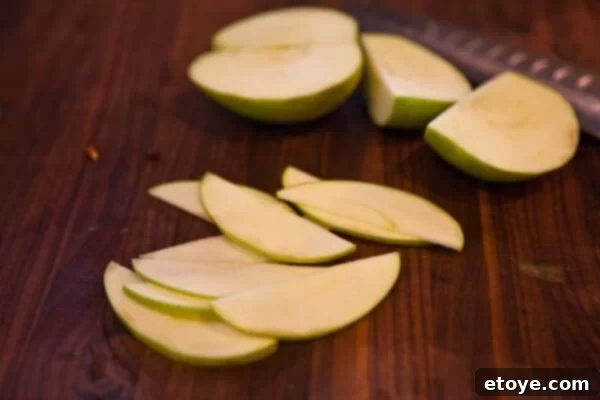
Finally, you’ll transform these elegant thin slices into matchstick-like strips. This creates an appealing, manageable apple component that integrates seamlessly into the slaw, providing just the right amount of crunch and flavor. The objective is to have apple pieces that are similar in size and shape to your julienned celery and carrots, ensuring a perfectly balanced texture in every single forkful. The natural crispness of a Granny Smith apple, in particular, holds up wonderfully in the dressing, maintaining its refreshing crunch throughout the meal.

Carrot Preparation: Sharp Tools or Smart Shortcuts for Julienne
Carrots are a wonderful addition to this apple slaw, lending a beautiful burst of vibrant color, a natural sweetness, and a satisfying, earthy crunch. When it comes to preparing them, you have a couple of excellent options depending on your preference and kitchen tools. For those seeking maximum convenience and time-saving, many grocery stores offer high-quality pre-cut matchstick carrots. If you choose this shortcut, be sure to select a fresh, crisp package to ensure the best possible texture for your slaw.
However, if you prefer the fresh taste and control of julienning them yourself, it’s absolutely achievable and can yield superior results. The paramount rule here, as with any precise knife work, is to use a very sharp chef’s knife. Attempting to julienne skinny, round, or particularly hard carrots with a dull knife can be an exercise in frustration, and more importantly, poses a significant safety hazard. A properly sharp blade will glide cleanly through the carrot, allowing you to create those delicate, uniform matchstick strips with ease. If a very sharp knife isn’t readily available, consider alternative tools like a mandoline slicer equipped with a julienne attachment, or even a spiralizer, which can produce lovely thin strands for a slightly different yet equally delicious texture. Always prioritize safety in your kitchen and employ proper cutting techniques.
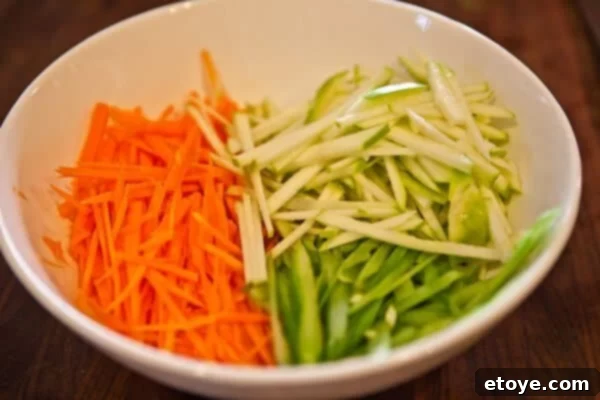
Crafting the Creamy & Tangy Apple Cider Dressing
The dressing for this apple slaw is a true testament to simplicity delivering big on flavor. It’s carefully designed to complement, rather than overwhelm, the fresh, crisp ingredients, creating a harmonious and balanced experience. This creamy, tangy, and subtly sweet concoction is what truly marries all the elements of the slaw together. Its foundation is plain yogurt, which contributes a wonderfully light, creamy texture and a pleasant, mild tang, making it a healthier and lighter alternative to traditional mayonnaise-based dressings.
A generous splash of apple cider vinegar introduces a bright, lively acidity. This not only enhances the natural apple notes within the slaw but also provides a refreshing zing that awakens the palate. Grainy Dijon mustard plays a vital role, adding a subtle piquancy and an intriguing textural element with its tiny mustard seeds. A touch of golden honey is then incorporated to delicately balance the tartness with a natural, gentle sweetness. Finally, a pinch of salt is crucial for bringing all these diverse flavors into perfect harmony. This thoughtful combination results in a dressing that is both vibrantly fresh and satisfyingly comforting, flawlessly coating each piece of vegetable and fruit without ever making them soggy, ensuring a delightful bite every time.

The Magic of Poppy Seeds: Elevating Your Slaw to New Heights
While each component of this apple slaw is delicious in its own right, what truly elevates it from simply good to absolutely unforgettable is the unexpected, yet inspired, addition of poppy seeds. These tiny, unassuming seeds are culinary marvels, bringing a unique depth of flavor, a subtle nutty undertone, and a delightful textural pop that transforms the entire dish. They introduce a layer of sophisticated complexity and an intriguing visual appeal, making each bite a fascinating exploration of both taste and texture. Poppy seeds are indeed the secret ingredient that takes this slaw to an entirely new level, making it memorable and distinctive.
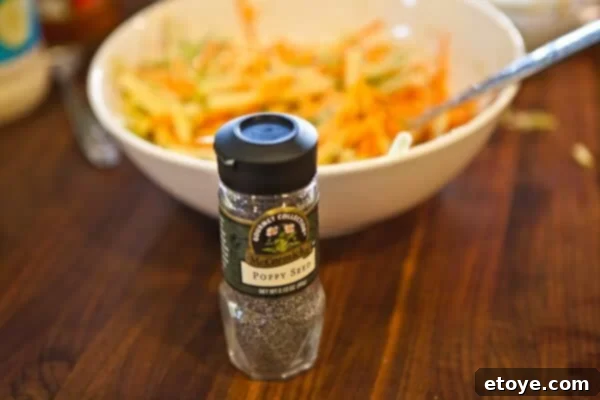
Unlocking the Potential of Poppy Seeds: Insights from McCormick Gourmet
As a proud member of the McCormick Gourmet team of bloggers, where I have the privilege of developing innovative recipes featuring their exceptional spices, and also serving on the chef panel that helped craft the McCormick 2011 Flavor Forecast by predicting upcoming culinary trends, I’ve cultivated a deep appreciation for the transformative power of high-quality spices. Poppy seeds, often underestimated, are a prime example of a spice that can truly make a dish sing. Let’s explore the fascinating world of poppy seeds, drawing valuable insights from the authoritative McCormick Gourmet Enspiceopedia.
Botanically Speaking: The Poppy Plant’s Harmless Seeds
While the poppy plant itself, scientifically known as Papaver somniferum (meaning “sleep bearing”), is infamous as the source of opium, it’s a critical distinction that its tiny, dried seeds harbor no narcotic properties whatsoever. This common misconception often leads to confusion, but the culinary seeds are entirely safe for consumption. These resilient annual plants are known for producing showy, vividly colored flowers, from which we harvest their richly colored, distinctively slate-blue seeds. These small seeds are highly prized in the culinary world for their characteristic nutty flavor, which can be further enhanced when lightly toasted. Poppy seeds are predominantly available in their whole, untouched form, preserving their natural integrity and versatility for a wide range of culinary applications.
The Yum Factor: Poppy Seeds in Global Cuisine
The culinary versatility of poppy seeds is surprisingly extensive and consistently delicious. Their subtle crunch and unique flavor profile make them an invaluable addition to a myriad of dishes, spanning both sweet and savory realms. They are a classic topping, famously sprinkled on an array of baked goods – from savory breadsticks, bagels, and rolls to sweet cakes, muffins, and pastries – where they provide both textural intrigue and a delicate, earthy note. Beyond baking, poppy seeds are a wonderful ingredient to whisk into salad dressings, lending a pleasant depth and a satisfying texture to both fruit-based and green salads. They can also be elegantly swirled into various egg dishes, such as fluffy scrambles or rich quiches, and incorporated into potato preparations, like roasted potatoes or creamy potato salads, where they impart a delightful visual appeal and an added dimension of taste.
Whether lightly toasted to intensify their nutty aroma or used raw for a milder flavor, these tiny blue-black seeds hold a prominent place in the cuisines of numerous cultures. They are a staple in Eastern European culinary traditions, frequently found in both sweet pastries and savory dishes, and are a beloved ingredient in German baking. Indian cuisine cleverly integrates them into complex curries and intricate spice blends, while Turkish dishes often feature them for their distinctive taste and unique texture. This widespread global presence underscores their universal appeal and remarkable adaptability across diverse culinary landscapes.
Globetrotter’s Guide: Origins and Prized Varieties of Poppy Seeds
Although the poppy plant is indigenous to the ancient regions of the Eastern Mediterranean, today’s commercially harvested poppy seeds primarily originate from two major global suppliers: the Netherlands and Australia. Both nations are recognized for producing high-quality poppy seeds, but the Dutch variety, in particular, holds a revered status within the culinary community. It is especially prized for its exceptionally uniform slate-blue color, a visual characteristic that denotes its premium quality and consistent nature. This highly desirable uniform color is often preferred by professional chefs and home bakers alike for its aesthetic contribution to finished dishes, reflecting a meticulous cultivation and harvesting process that ensures a superior product for consumers around the globe.
Believe It…Or Not: A Symbol of Deep Esteem and Remembrance
The history of the poppy plant stretches back over three millennia, solidifying its place as one of humanity’s oldest cultivated plants. Throughout its long and storied past, the vibrant, deep red flower of the poppy plant has acquired profound symbolic meaning, most notably as a powerful emblem of esteem and poignant remembrance for fallen warriors. This symbolism gained particular resonance following the devastation of World War I, largely inspired by Lieutenant Colonel John McCrae’s iconic poem, “In Flanders Fields.” In the United States, the vibrant poppy flowers are frequently used to commemorate Veterans Day, serving as a solemn and beautiful reminder of the immense sacrifices made by service members. This rich tapestry of historical and cultural significance adds another layer of profound appreciation for this seemingly simple plant, connecting its culinary uses to a deeper human narrative of honor, memory, and enduring respect.
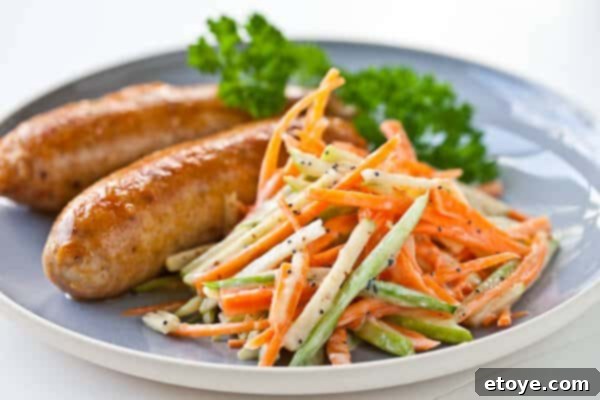
Chicken Sausage with Apple Slaw Recipe
There’s a significant secret to perfectly cooking large sausages, and it involves either keeping the flame consistently low or employing a smart combination method of steaming and grilling. The main challenge with larger sausages is that their casings can easily burst when exposed to high heat too quickly, which results in a drier and less appealing final product. To circumvent this, if you’re grilling outdoors on your BBQ, strategically arrange half of your grill grates over low heat and the other half over medium heat. Begin by cooking the sausages on the hotter side just long enough to achieve beautiful grill marks and a flavorful sear. Then, transfer them to the low heat section, cover the grill, and allow them to finish cooking through gently. This two-stage method ensures they cook evenly from the inside out without bursting or drying, preserving their inherent juiciness and rich flavor.
If you prefer to cook on your stovetop, simply follow the detailed instructions provided in the recipe below for consistently delicious and perfectly cooked sausages every time.
Regarding the dressing, my preferred method is to prepare it in a separate bowl first. Once the dressing is thoroughly whisked and combined, I initially add only about half of it to the slaw ingredients. I then toss everything meticulously to ensure an even coating before tasting. This gradual approach allows for precise adjustments based on your personal flavor preference and the exact quantity of vegetables and fruit in your bowl (since, as we know, not all carrots or apples are the same size!). You always have the option to add more dressing incrementally until you achieve your desired flavor balance, guaranteeing a perfectly seasoned slaw that is never overdressed.
Print Recipe
Prep Time: 10 mins
Cook Time: 15 mins
Servings: 4
Ingredients
- 8 chicken sausage links
- 2 teaspoons cooking oil
- 1/2 cup liquid: beer, water or apple juice
- 2 tablespoons lowfat or nonfat plain yogurt
- 1 tablespoon grainy Dijon mustard
- 1/2 teaspoon salt
- 1 teaspoon honey
- 1 tablespoon apple cider vinegar
- 1/2 teaspoon poppy seeds
- 1 large carrot, cut into julienne (or 1 cup matchstick-cut carrots)
- 1-2 stalks celery, cut into julienne
- 1 granny smith apple, cut into matchstick
Instructions
- Cook the Sausage: Grab a large frying pan or sauté pan that has a lid. Turn the heat to medium and swirl in the cooking oil. Once the oil is hot and shimmering, add the chicken sausage links and cook, turning occasionally, until all sides are beautifully browned and caramelized. Carefully pour in your chosen liquid (beer, water, or apple juice), then immediately cover the pan with the lid. Reduce the heat to medium-low and let the sausages gently cook for 3-5 minutes, allowing them to steam through and finish cooking evenly, ensuring they remain wonderfully juicy and flavorful without bursting their casings.
- Prepare the Dressing: In a separate medium-sized mixing bowl, combine the lowfat or nonfat plain yogurt, grainy Dijon mustard, salt, honey, apple cider vinegar, and poppy seeds. Whisk all the ingredients together vigorously until they are thoroughly combined and the dressing is smooth. Taste the dressing and adjust the seasoning if necessary, ensuring a perfect balance of tangy, sweet, and savory notes.
- Assemble the Slaw: In a large mixing bowl, combine the prepared julienned carrots, julienned celery, and matchstick-cut apple. Add approximately half of the prepared dressing to the mixture of vegetables and fruit. Toss everything gently but thoroughly to ensure all the ingredients are lightly and evenly coated. Taste the slaw to assess the flavor, then gradually add more dressing, a spoonful at a time, until you achieve your desired level of flavor and moistness. Serve the delicious chicken sausage immediately alongside the fresh and vibrant apple slaw for a perfectly balanced and satisfying meal.
Tried this recipe? Let us know how it was!
